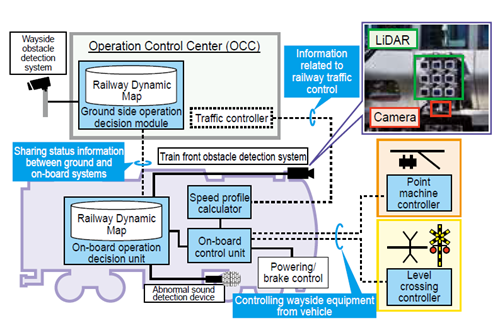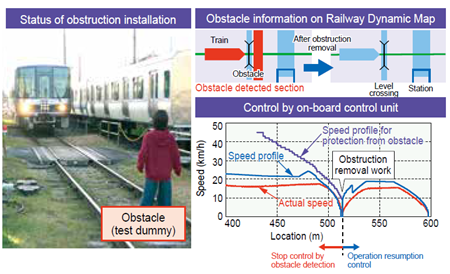15. Autonomous Train Operation System
We are engaged in the research and development of an autonomous train operation system that goes beyond conventional automatic driving, aiming to reduce labor and manpower across the entire train operation process, including driving, maintenance, and train operation control. This system provides trains with information such as the presence of obstacles on railway tracks or along waysides, and operation controls due to maintenance work or natural disasters, enabling each train to assess the situation autonomously. The goal is to achieve safe and flexible train operations.
This system consists of an on-board control unit, an operation decision module, a speed profile calculator, a train front obstacle detection system, an abnormal sound detection device, a wayside obstacle detection system, a traffic controller, point machine controllers and level crossing controllers (Figure 1). These devices work in coordination, with information detected by the monitoring systems mapped on the Railway Dynamic Map within the operation decision unit. This information is shared between ground and on-board systems, as well as among trains, enabling each train to autonomously determine whether to continue operation, avoid hazardous events automatically, and resume operation when appropriate.
Using a prototype system, we conducted demonstration tests on the test track at the Railway Technical Research Institute. Through these tests, we confirmed several key functions: automatic train operation while controlling wayside equipment in accordance with calculated speed profiles; automatic hazard avoidance by having the on-board operation decision unit command the train to stop based on information from the train front obstacle detection system detecting obstacle on the railway track; and resumption of operation after the obstacle is removed, based on automatic judgment by the on-board operation decision module (Figure 2).
This system enables direct control of wayside equipment from on-board units, allowing for a reduction in ground-based interlocking devices and thereby reducing labor of the construction and maintenance of ground equipment. Furthermore, the automatic generation of speed profiles is expected to improve the efficiency of train operation control. This system serves as a core technology for future labor and manpower reduction across the entire train operation process. Additionally, the technologies for obstacle detection, information sharing and operation decision-making using the Railway Dynamic Map can be applied to enable driverless operation
on conventional lines with level crossings, as well as to improve current train operation practices.
Other Contents
- 9. Design Method for Post-installed Anchor Joint Members in the Reconstruction of Concrete Structures
- 10. Reinforcement Method for Preventing Fatigue Cracks at Steel Girder Support Sections
- 11. Method for Identifying Potentially Critical Locations of Loose Bearing Based on On-board-measured Track Geometry
- 12. Extension of Rail Replacement Cycles Considering Fatigue/Soundness
- 13. Support Method for Extending Inspection Periods Based on Statistical Analysis of Equipment Inspection Records
- 14. Automated Visual Inspection System for Vehicle Underbody
- 15. Autonomous Train Operation System
- 16. General Purpose Real-time Algorithm for Generating Driving Curves for Driver Advisory System
- 17. Method for Updating On-board Databases Using Public Communication Networks
- 18. Labor-saving for Generating Crew Schedule to Enable Workforce Efficiency and Reduce Labor Burden
- 9. Design Method for Post-installed Anchor Joint Members in the Reconstruction of Concrete Structures
- 10. Reinforcement Method for Preventing Fatigue Cracks at Steel Girder Support Sections
- 11. Method for Identifying Potentially Critical Locations of Loose Bearing Based on On-board-measured Track Geometry
- 12. Extension of Rail Replacement Cycles Considering Fatigue/Soundness
- 13. Support Method for Extending Inspection Periods Based on Statistical Analysis of Equipment Inspection Records
- 14. Automated Visual Inspection System for Vehicle Underbody
- 15. Autonomous Train Operation System
- 16. General Purpose Real-time Algorithm for Generating Driving Curves for Driver Advisory System
- 17. Method for Updating On-board Databases Using Public Communication Networks
- 18. Labor-saving for Generating Crew Schedule to Enable Workforce Efficiency and Reduce Labor Burden


